Eridanus, a constellation situated in the southern hemisphere, is a prominent feature in the night sky. Despite its size, Eridanus is easily visible from various locations in Russia. Ranking sixth in terms of area among other constellations, Eridanus offers numerous captivating objects for astronomers to observe and study worldwide.
Brief overview
Eridanus constellation is ranked second in terms of length, just behind the well-known Hydra. It covers an impressive area of approximately 1138 square degrees. Within this vast expanse, there are 187 stars that can be observed without the need for specialized equipment.
Eridanus is home to stars of varying ages and sizes. It is situated near other prominent constellations such as Orion, Taurus, Whale, and Phoenix. The constellation’s Latin name is Eridanus, and its abbreviation is Eri.
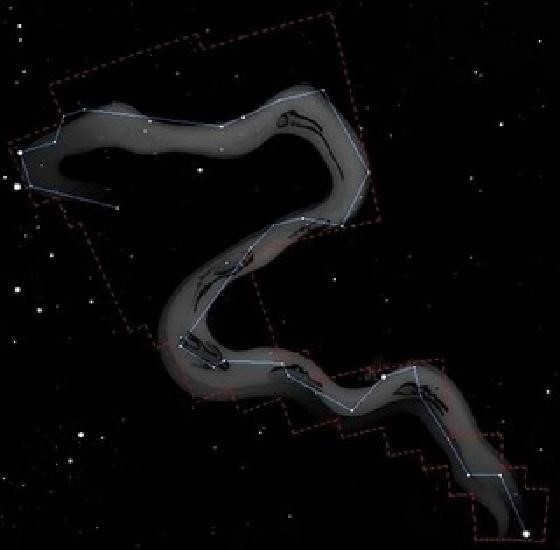

Analysis
As has been previously stated, a portion of the heavenly body can be documented from any location within Russia, as well as numerous neighboring countries. However, the more southern the vantage point for observations, the greater the portion of the Eridanus constellation will be visible in the resulting photograph. Regrettably, it is not possible to view the southernmost and brightest star, Ahernar, from within Russian territory. It is worth mentioning that the ideal time to observe the constellation is during the latter part of autumn.
History and legends
The constellation Eridanus has a long and mysterious history. Its origins date back to ancient times, although the exact details of its discovery remain uncertain. The first recorded mention of Eridanus can be traced back to the fifth century BC, when the philosopher Eudoxus of Ancient Greece described it. However, it gained wider recognition and was officially named in the first century AD in the “Almagest”, a catalog of the night sky compiled by the renowned astronomer Claudius Ptolemy.
There are multiple legends surrounding the origin of the name Eridanus for the constellation. All of them revolve around Phaeton, the son of the sun god Helios. According to ancient Greek texts, the Eridanus River corresponds to either the Nile, Po, or Euphrates Rivers. The myth of Phaethon recounts how he embarked on a journey in his father’s celestial chariot but lost control of it. As the chariot neared the Earth, a raging fire broke out. To avert catastrophe, the god Zeus intervened by striking Phaeton with a bolt of lightning, causing him to plunge into the river.
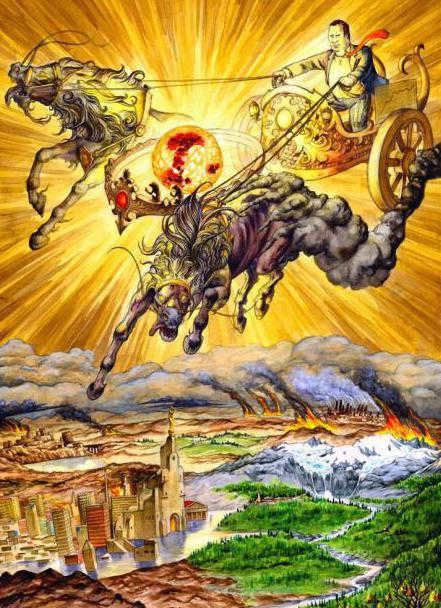
The Celestial Bodies of the Eridanus Constellation
Within this particular constellation, there are numerous notable celestial bodies, including first magnitude stars, seven stars known to have planets, as well as double and triple stars. Many of these stars hold significant scientific value. Take, for example, 82 Eridanus, a star that has existed for over six billion years. This makes it considerably older than our own Sun, although it is less massive. In 2011, three planets were discovered orbiting around 82 Eridanus.
Another noteworthy star within the Eridanus constellation is Theta Eridanus, which goes by the name Akamar. Interestingly, its name shares consonance with the alpha star of the Eridanus constellation. The largest star in this particular celestial object is known as Ahernar. Translated, these names signify “end of the river”. This is because, during ancient times in Greece, Ahernar could not be observed as it was situated to the south. Consequently, the Greeks regarded the star Akamar as the terminus of the celestial river.
Alpha
Ahernar, located in the constellation Eridanus, stands out as the brightest and southernmost star in the night sky. Among the myriad celestial objects, it ranks ninth in terms of brightness. What sets Alpha apart is its distinctive shape – a rapidly rotating flattened spheroid. Its equatorial diameter is twice as large as its polar diameter, giving it a unique appearance. Not only is Ahernar visually stunning, but it also holds the title of the hottest and bluest star in the sky, boasting an apparent magnitude of 0.445.
Ahernar, a supergiant star, shines with the brilliance of a first magnitude star. Its size far surpasses that of our Sun, with a mass eight times greater. Located approximately 140 light-years away from our solar system, Ahernar is accompanied by a companion star, which shares a mass equivalent to twice that of our Sun.
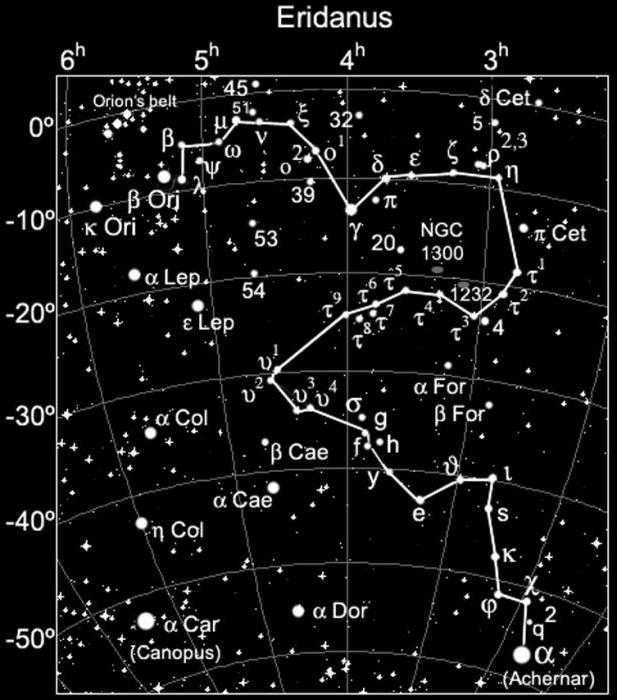
Betta
Betta, located in the constellation Eridanus, is known by two different names. Originally, it was referred to as Dalim, which is of Arabic origin and means “ostrich”. Along with three other stars (lambda and psi of Eridanus and tau of Orion), Betta forms a group called the ostrich’s nest. However, this stellar asterism was later given a different name, Orion’s Bench. Consequently, the star was also assigned a new name, Kursa, meaning “footstool” in Arabic.
In contrast to Ahernar, Betta marks the beginning of the celestial river. It is the second brightest star in Eridanus and is located almost 90 light years away from Earth. In terms of its physical characteristics, Kursa surpasses the Sun. It has a diameter three times larger and a mass two and a half times greater than that of the Sun.
Gamma
Zaurak, the third planet of the Eridanus star system, derives its name from the Arabic word for “boat”. With a stellar magnitude of 2.95, this celestial body is easily visible to the naked eye. Zaurak is classified as a red giant, characterized by its lower temperature but higher luminosity, which is 220 times greater than that of the Sun. Located 203 light years away from our solar system, Zaurak boasts a radius more than 42 times that of the Sun.
What is epsilon?
Epsilon is the phonetic representation of the fifth letter of the Greek alphabet. Additionally, it also refers to a celestial body located in the constellation Eridanus, which shares similar qualities with our own Sun. In historical records from the 14th century, it was referred to as Al-Sadira in Arabic, but it remained nameless for a considerable period of time. Nevertheless, in 2015, the International Astronomical Union officially designated the star as Ran, after a sea giantess in Ancient Scandinavian mythology.

Epsilon Eridanus is situated at a relatively close distance of 10.5 light-years from the Sun, which is considered small in the vast expanse of the cosmos. This star stands out due to its remarkably rapid rotation, completing a full revolution around its axis in just 11 days. Additionally, it possesses a formidable magnetic field. Epsilon Eridanus exhibits a luminosity that is 30% lower than that of the Sun, as well as a mass that is 15% less. Astronomers have determined that this star is relatively young in cosmic terms, with an age of approximately half a billion years.
In 2008, American astronomers made a significant discovery near Epsilon Eridanus, identifying the presence of two asteroid belts. These belts are located at distances of 3 and 20 astronomical units from the star. Additionally, approximately one year later, a planet was detected within the Eridanus epsilon system. This planet bears resemblance to Jupiter and exhibits a highly elongated orbit around its host star. In 2015, the planet was officially named Aegir, drawing inspiration from the character in Ancient Scandinavian mythology who is known as the husband and brother of Ran.
Witch’s Head and Cleopatra’s Eye
Within the Eridanus constellation, numerous fascinating entities have been uncovered. Among them is the reflection nebula IC 2118, known as the Witch’s Head. This moniker was bestowed upon it as a result of its peculiar form, which distinctly mirrors the profile of a human with a crooked nose and pointed chin.
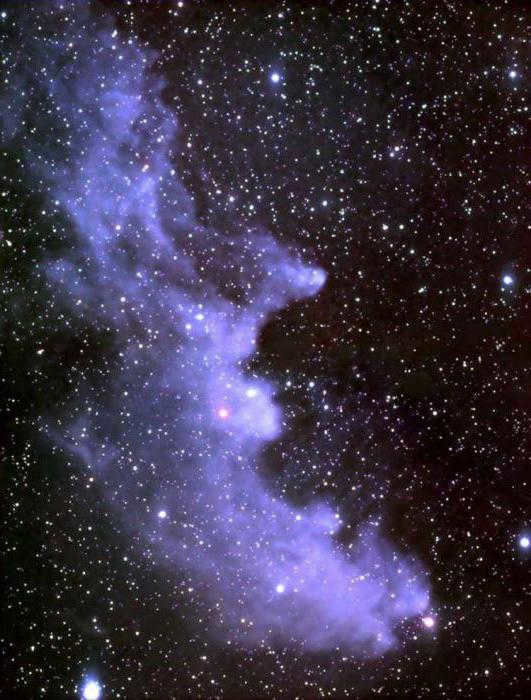
The nebula is made up of fine dust that reflects the light of the bright star Rigel in the Orion constellation. Covering an area of 1,940 square degrees, scientists believe that it may be in the initial stages of star formation, as compact objects are present within it. Located 900 light-years away from our system, the Witch’s Head is a fascinating sight.
The planetary nebula NGC 1535 is commonly referred to as Cleopatra’s Eye. It features a disk of blue-white color with two rings, with a 17 magnitude star at its center. Despite its relatively small size, observing this nebula requires the use of powerful equipment.
Multiple star systems
There are numerous multiple star systems discovered within the constellation Eridanus. One of the most captivating to observe is Omicron-2, also known as Cade (derived from the Arabic word for “shell”) or 40 Eridana. This particular triple star system is situated approximately 16.5 light-years away from our Sun.
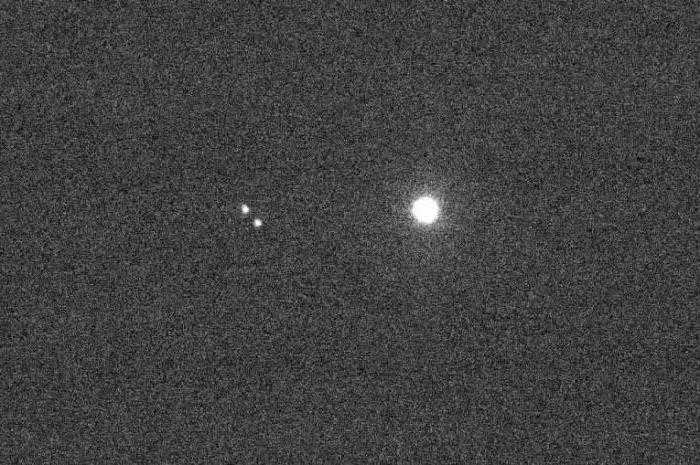
The most prominent entity is known as 40 Eridana A. It is an orange dwarf that has been in existence for approximately 5.6 billion years. With a stellar magnitude of 4.42, it can be observed in the sky without any specialized equipment. Surrounding this star, there is a pair of orbiting objects called 40 Eridanus VS. These objects are located at a distance of 400 astronomical units from the central star and complete a full revolution approximately every 8 thousand years. Alongside 40 Eridana A, there are two companion stars, namely 40 Eridana B and 40 Eridana C. 40 Eridana B is classified as a white dwarf and has half the mass of our Sun. On the other hand, 40 Eridana C is five times smaller than the Sun and is categorized as a red dwarf. This particular red dwarf is part of a group of stars known for their flaring behavior, which means that its luminosity has the potential to increase several times over.
A vast emptiness
Regarded as the most extraordinary entity within the constellation, a super void known as a relic cold spot stands out. It encompasses an immense expanse of space completely void of galaxies, stars, and matter. Such entities are referred to as voids, derived from the English term “void” meaning emptiness.
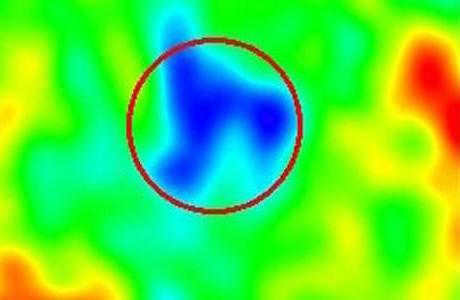
This colossal cosmic anomaly is truly remarkable in terms of its immense size. Spanning nearly a billion light years in diameter, it stands as the largest known super void in existence. What sets this void in the Eridanus constellation apart even further is the absence of any detectable dark matter within it. It is an absolute void, defying our current understanding of the universe. Scientists are still grappling with the enigma of its origin, with one theory proposing that this super void serves as a nexus between our universe and another parallel dimension.
Eridanus, a constellation situated in the southern hemisphere, derives its name from an ancient Greek river that flowed through Italy.
Ptolemy was responsible for cataloguing the constellation Eridanus in the second century. Within this constellation, there are several notable celestial objects, including Ahernar, which is one of the brightest stars visible in the sky. Epsilon Eridanus is the closest star to Earth located within this constellation. Additionally, the Eridanus Galaxy Cluster and the Witch’s Head Nebula can also be found within the boundaries of Eridanus.
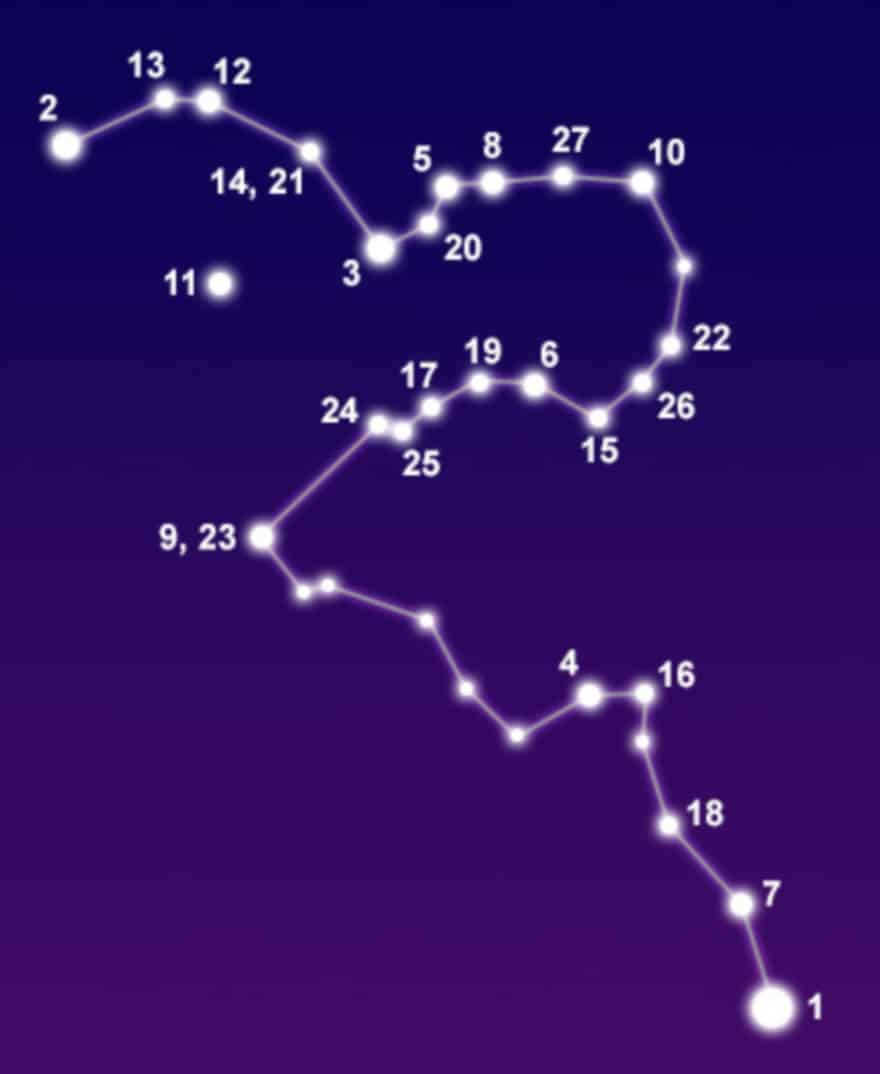
Facts, Position, and Map
Eridanus, a constellation covering an area of 1138 square degrees, is the 6th largest constellation in terms of size. It occupies the first quadrant of the southern hemisphere (SQ1) and can be observed at latitudes ranging from +32° to -90°. Eridanus is bordered by Tucan, Taurus, Phoenix, Orion, Hare, Southern Hydra, Clock, Whale, Cutter, and Furnace.
This constellation is home to 7 stars with planets, but does not contain any Messier objects or meteor streams. The brightest star in Eridanus is Ahernar, which has an apparent visual magnitude of 0.445. It is also the 9th brightest star in the sky. Eridanus is part of the Celestial Waters group, where you can also find the Dove, Dolphin, Sails, Compass, Stern, Southern Fish, Lesser Horse, and Keel. To get a better understanding of the constellation Eridanus, refer to the diagram on a star map.
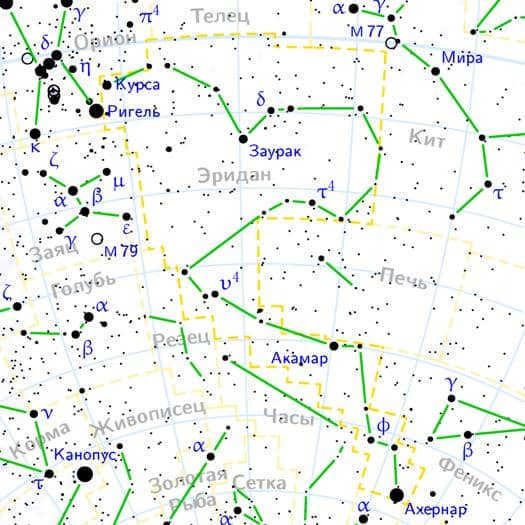
Legend
In ancient Greek mythology, the constellation Eridanus was linked to the story of Phaeton. Phaeton was the offspring of Helios, the god of the Sun, and Clymene, an oceanid. Phaeton had a desire to embark on a new celestial journey using his father’s chariot, but Helios instructed him to follow a predetermined path where the wheel tracks were visible.
Phaethon assumed control of the chariot and soared into the heavens, finding the task surprisingly effortless. Feeling confident, he made a sudden turn, causing him to lose control. The chariot plummeted towards the earth, skimming so close to the surface that it ignited. As a result, the arid expanse known as the Libyan desert came into existence, with its dried-up seas and darkened Ethiopians. Witnessing the catastrophe, Zeus intervened and put an end to it. Enraged, he hurled a thunderbolt at Phaethon, causing him to crash into the river Eridanus. Helios, devastated by the tragedy, refused to release his chariot for several days, casting the entire world into darkness.
The poet Aratus named this constellation, while Ptolemy referred to it as Potamos, meaning “river.” Erastothenes believed it represented the Nile, which flows from south to north. The Latin author Hyginus supported this idea, pointing out that the bright star Canopus (part of the constellation Carina) is located at the end of the river, similar to the island of Canopus at the mouth of the Egyptian river. Later, Latin and Greek authors suggested that the myth referred to the Po River in Italy.
Alternatively, the name could be derived from the Babylonian constellation known as the Star of Eridu (MUL.NUN.KI). Eridu was a sacred city for the god Enki in Babylon, symbolized by a subterranean water reservoir.
Discover the brilliant celestial bodies of the constellation Eridanus in the southern hemisphere, complete with detailed descriptions and characterization.
Ahernar (Alpha Eridanus) is a B6 Vep main-sequence star, boasting a mass 6-8 times greater than the Sun and a luminosity 3150 times brighter. It claims the top spot in terms of brightness within the constellation and ranks 9th in the entire sky. Situated in the southern corner, Ahernar exhibits an apparent visual magnitude of 0.445 and is located at a distance of 139 light-years. Among the ten brightest stars in the sky, it stands out as the hottest and bluest. It never ascends beyond the horizon north of 33°N or descends below the horizon south of 33°S. The optimal time to observe Ahernar in the southern hemisphere is in November.
In addition, Ahernar features a class A star in a close orbit with a mass twice that of the Sun. These two bodies are separated by a distance of 12.3 astronomical units and revolve around each other with a period of 14-15 years. This star is classified as a Lambda Eridanus-type variable.
Ahernar is known for its remarkable rotational speed, making it the most rapidly spinning star in the entire Milky Way galaxy. As a result of this intense rotation, Ahernar has a highly unique shape that sets it apart from all other stars. Its form can be described as a flattened spheroid, with its equatorial diameter measuring 56% larger than its polar diameter. This distinctive shape has also led to the formation of a circumstellar gas disk surrounding Ahernar. Interestingly, the name “Ahernar” originates from the Arabic phrase “ākhir an-nahr,” which translates to “End of the River.”
Kursa, also known as Beta Eridanus, is an impressive giant star classified as A3 III. With an apparent magnitude of 2.796, Kursa is the second brightest star in its constellation. Located approximately 89 light-years away, Kursa can be observed near the boundary of the Orion constellation. Notably, Kursa has a visual companion that is situated 120 arc seconds away and possesses an apparent magnitude of 10.90.
The star possesses a rotational velocity of 196 km/s. It exhibits variability in its visual brightness, ranging from 2.72 to 2.80 in magnitude. The name “Kursa” is derived from the Arabic term “Al Kursiyy al Jauzah,” which translates to “bench.” Kursa is a member of a stellar group that also includes Lambda Eridana, Psi Eridana, and Tau Orion (located in the constellation of Orion).
Akamar (Theta Eridana) is a binary star that could potentially be part of a multiple star system. The primary component belongs to the spectral class A4 and has a visual magnitude of 3.2. The secondary component is classified as an A1 star and has an apparent magnitude of 4.3. The two stars are separated by an angular distance of 8.3 seconds. The combined apparent visual magnitude is 3.2, and the distance to Akamar is estimated to be 161 light-years.
Ākhir an-nahr, which means “end of the river” in Arabic, was the original name for the star that represented the end of the celestial river Eridanus. However, this role is now played by the star Ahernar. Despite the change in names, Ahernar and Ākhir an-nahr share a common origin. Ahernar was not visible in Greece, so Hipparchus and Ptolemy opted to use Akamar as the marker for the end of the river.
Zaurak, also known as Gamma Eridanus, is a star (M1IIIb) with a visual magnitude of 2.95. It is situated approximately 150 light-years away from our solar system. The Arabic translation of Zaurak is “boat”.
Rana, or Delta Eridana, is a subgiant (K0 IV) with a visual magnitude of 3.54 and a distance of 29.49 light-years. The word “Rana” originates from Latin and means “frog”.
Τ4 Eridana, or Tau-4 Eridana, is a double star (M3.5III) with a visual magnitude of 3.70. Its distance from us is approximately 258 light-years. The primary component of this system is an M-class giant with a visual magnitude of 3.66.
E Eridana (Epsilon Eridana) is a K2V star located at a distance of 10,489 light-years from Earth. With an apparent magnitude of 3.736, it is slightly dimmer than our Sun, measuring 82% of its mass and 74% of its radius.
This star holds the ninth position in terms of proximity to the Sun, and it is the third closest individual star or star system that can be observed without the need for binoculars. Prior to the discovery of Alpha Centauri Bb, it was the nearest star known to have a confirmed planet in its orbit.
With an estimated age of 440 million years, E Eridana is surrounded by a vast outer disk composed of debris. Unfortunately, due to the prevalence of light pollution, it can be quite challenging for residents of large cities to locate this star using binoculars. Additionally, E Eridana is classified as a variable BY Dragon.
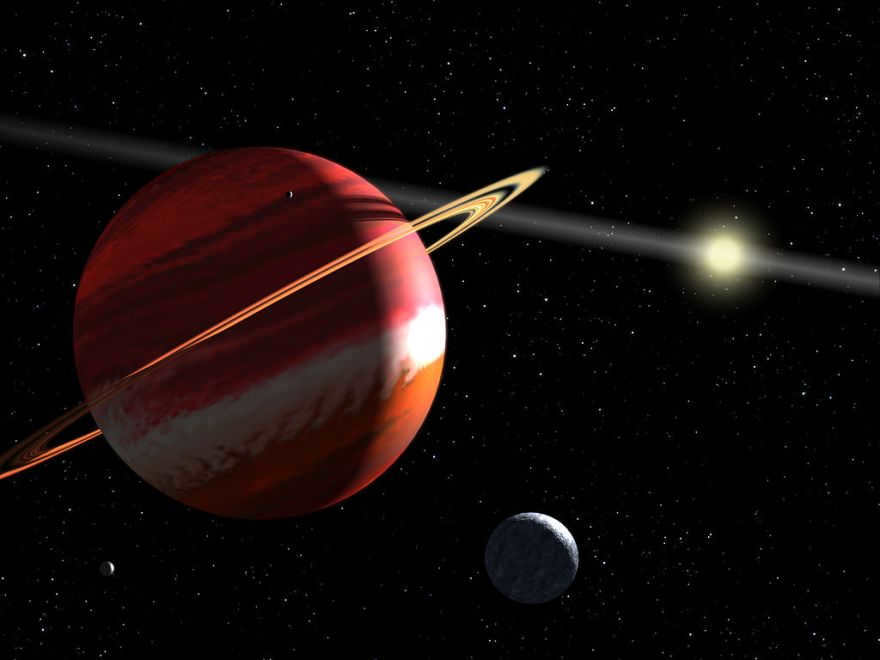
Due to its proximity to the Sun, SETI (Search for Extraterrestrial Intelligence) closely monitors the star and it has also been featured in various works of science fiction. In the year 2000, astronomers discovered a large planet, known as Epsilon Eridana b, orbiting this star with a period of 7 years.
Cade, also known as 40 Eridana or Omicron-2 Eridana, is a triple star system. The name “Cade” is derived from the Arabic word “qayd,” which means “(egg) shell”.
40 Eridana A is a main-sequence dwarf, classified as a K1 star, with an apparent magnitude of 4.43, making it visible to the naked eye. The other two stars in the system, 40 Eridanus B and 40 Eridanus C, are white (DA4) and red dwarfs (M4.5e), with visual magnitudes of 9.52 and 11.17 respectively. These stars were first observed by William Herschel on January 31, 1783. The second star in the system is known as DY Eridanus and is known to undergo flaring events.
If you are a fan of Star Trek, you may recall the planet Vulcan. Initially, it was depicted as being in the orbit of the star Alnitak in the constellation Orion. However, in the script for Star Trek II, author James Blish relocated the planet to the orbit of 40 Eridanus A.
82 Eridana (HD 20794) is a main-sequence star (G8V) with a visual magnitude of 4.254 and a distance of 19.71 light-years. It is smaller and less massive than the Sun, but significantly older. Its estimated age ranges from 6 to 12 billion years. Additionally, it is traveling at an exceptionally high velocity. On August 17, 2011, three super-Earths, which are larger than Earth in terms of mass, were discovered in its orbital path.
EF Eridana is classified as an AM Hercules type variable or polar, which is a specific type of cataclysmic binary variable featuring an incredibly powerful magnetic field. It is situated approximately 300 light years away from our location. The system’s visual magnitude varies between 14.5 and 17.3.
The system consists of a white dwarf and a former star that now orbits the white dwarf with a sub-stellar mass. The sub-stellar mass was once a star that transferred gas to the white dwarf, and it has now condensed into a ball with a mass of 0.05 solar masses.
Celestial objects
The Witch’s Head Nebula (IC 2118) is a faint reflecting nebula that is believed to be the remnants of an ancient supernova or a gas cloud illuminated by the neighboring bright star Rigel in the Orion constellation. It has an apparent visual magnitude of 13 and is located 1,000 light years away. The nebula gained recognition in the TV show Andromeda, where it served as the backdrop for the final major battle between the Commonwealth and the Nietzschean Alliance.
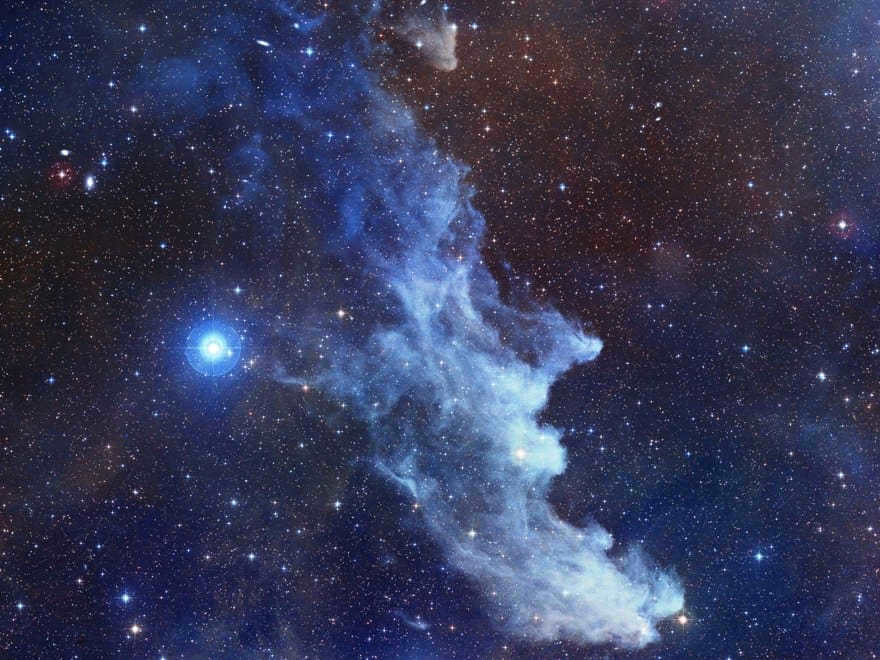

The Witch’s Head Nebula is linked to the star Rigel. It shines because of the star positioned outside the upper right corner. The dust of the nebula reflects the light. The blue color is not only attributed to Rigel’s color, but also because the dust particles reflect blue much better than red.
The Eridanus Group, also known as the Eridanus Cloud, is a cluster of galaxies located approximately 75 million light-years away from a central star. This cluster consists of around 200 galaxies, with 70% being spiral and irregular in shape, while the remaining 30% are lenticular and elliptical. The most luminous galaxy within the Eridanus Group is NGC 1407.
Within the Eridanus Group, there are several subgroups. One of these subgroups shares the same name as the overall cluster, the Eridanus Group. It contains nine objects from the New General Catalog (NGC) and two from the Index Catalog (IC). The most prominent galaxy in this subgroup is the elliptical galaxy NGC 1395. The other two subgroups are centered around the galaxies NGC 1407, a massive elliptical galaxy, and NGC 1332, a spiral galaxy.

The Hubble Space Telescope has captured an image of a spiral galaxy known as NGC 1300, which stands out due to its unique structure. This galaxy features a central bar that creates a spiral within a spiral, a phenomenon that is only observed in galaxies with large bars. Scientists believe that the gas inside the bar spirals inward and then escapes to the center through the disk, where it fuels a black hole. However, NGC 1300 does not have an active core, indicating that either there is no black hole present or it is not accreting matter.
NGC 1332, discovered by William Herschel on December 9, 1784, is another spiral galaxy with a visual magnitude of 10.3.
On the other hand, NGC 1395, also discovered by William Herschel on November 17, 1784, is a bright and large elliptical galaxy with a visual magnitude of 9.8.
NGC 1232 is a spiral galaxy with an apparent magnitude of 10.9 and a distance of 61 million light-years. It is located in the Eridanus Galaxy Cluster. NGC 1232A is a companion galaxy to NGC 1232. It is thought to have played a role in shaping the unique structure of the larger galaxy’s spiral arms.


This captivating photograph showcases the expansive NGC 1232 galaxy, photographed on September 21, 1998. The composite image is composed of three separate exposures, capturing the galaxy’s beauty in ultraviolet, blue, and red light. The vibrant colors of different regions are distinctly visible: the central area consists of mature red stars, while the spiral arms host youthful blue stars. Notably, there is an intriguing distorted companion galaxy resembling the Greek letter “theta” positioned on the left side.
NGC 1234 is a spiral galaxy that contains a junction. It has a visible visual magnitude of 15.3. This particular galaxy was discovered in 1886 by an American astronomer named Frank Leavenworth.
NGC 1535 is a planetary nebula that bears a striking resemblance to the Eskimo Nebula in the Gemini constellation, both in terms of structure and color. However, there is one notable difference – the central star in NGC 1535 is quite challenging to observe. This nebula is located 1500 light-years away.
NGC 1531 is a dwarf galaxy with a visual magnitude of 12.9. It is in close interaction with the larger NGC 1532. This spiral galaxy features a junction and is observed edge-on. Additionally, it has several satellite dwarf galaxies and is clearly engaged in interaction with one of them (NGC 1531).
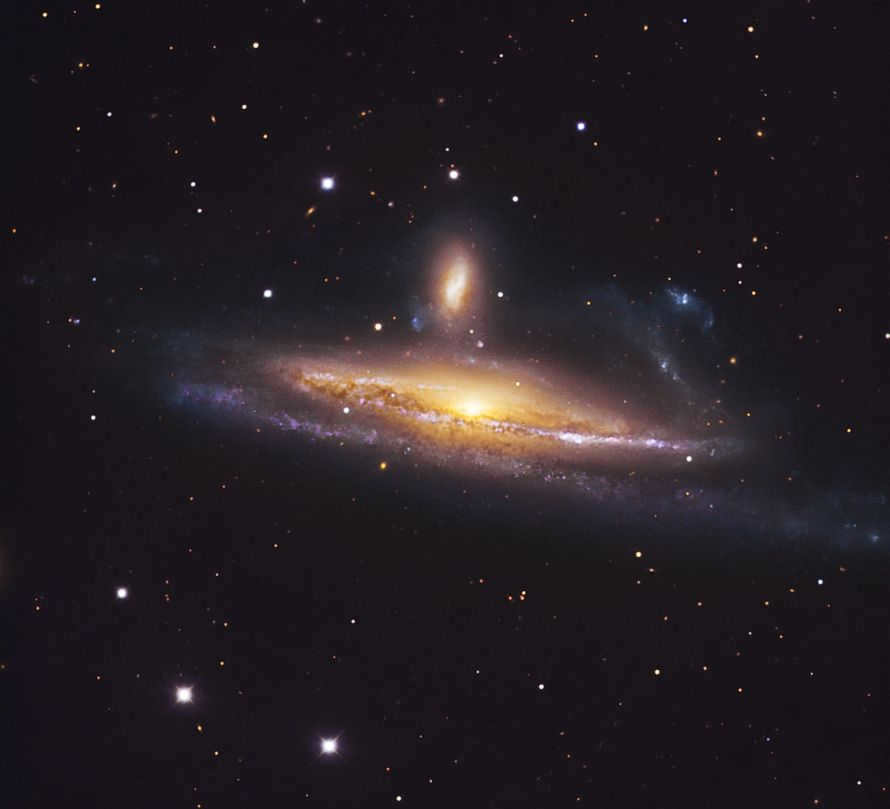
The Relict Cold Spot (also known as Eridanus Superhollow, CBM cold spot/WMAP cold spot) is the most extensive cold spot ever identified, representing a region in space devoid of galaxies. It spans a diameter of approximately one billion light-years.
Current theories regarding the origin of the universe fail to account for this phenomenon. However, there is a hypothesis that the cold spot may arise as a result of quantum entanglement between our universe and an alternate one.
The discovery of the Eridanus relic cold spot involved correlating the cold spot in the cosmic microwave background with the absence of radio galaxies. The cosmic microwave background radiation (CMB) pertains to the thermal radiation that permeates the entire observable Universe in a nearly uniform manner.
The CMB cold spot is an area of the Universe that has been detected in microwaves and is significantly larger and colder than the typical CMB emission. This extraordinary phenomenon has not been fully explained by current theoretical models.
NGC 1427A is a type of galaxy known as an irregular galaxy. It has a visual magnitude of 13.4 and is located approximately 51.9 million light-years away. NGC 1427A is the most luminous dwarf irregular galaxy in the Furnace Cluster and is positioned ahead of NGC 1399, which is the central galaxy in the cluster and is situated in the constellation Furnace.
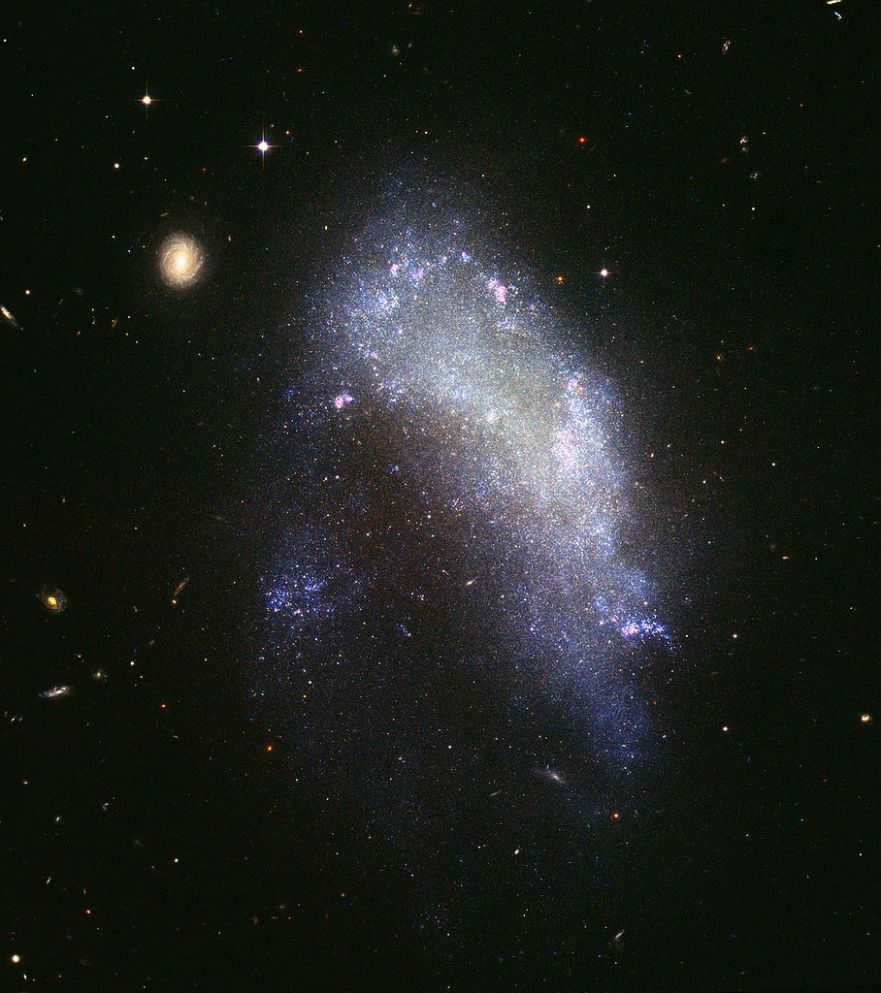
The galaxy NGC 1427A, which is irregular in shape, will not remain as a distinct galaxy for much longer as it travels through the Furnace Cluster at a speed of 600 km/s.
An example of a spiral galaxy observed in a face-on position is NGC 1309, which has a diameter of approximately 30,000 light-years. It is located 120 million light-years away from our own system. In the month of September in the year 2002, astronomers discovered a Type Ia supernova, known as SN 2002fk, within this galaxy. NGC 1309 is a member of the Eridanus group of galaxies. Its apparent visual magnitude is measured to be 12.0.

NGC 1291, also known as NGC 1269, is a unique ring galaxy located in the constellation Eridanus. It stands out due to its distinctive outer ring and inner bar structure. The discovery of NGC 1291 is credited to Scottish astronomer James Dunlop in 1826, and it was later included in the New General Catalog as NGC 1291.
In 1836, NGC 1291 was independently identified by John Herschel, who mistakenly named it NGC 1269, unaware of its existing NGC designation. This galaxy is situated approximately 33 million light years away from Earth and has an apparent visual magnitude of 9.39.
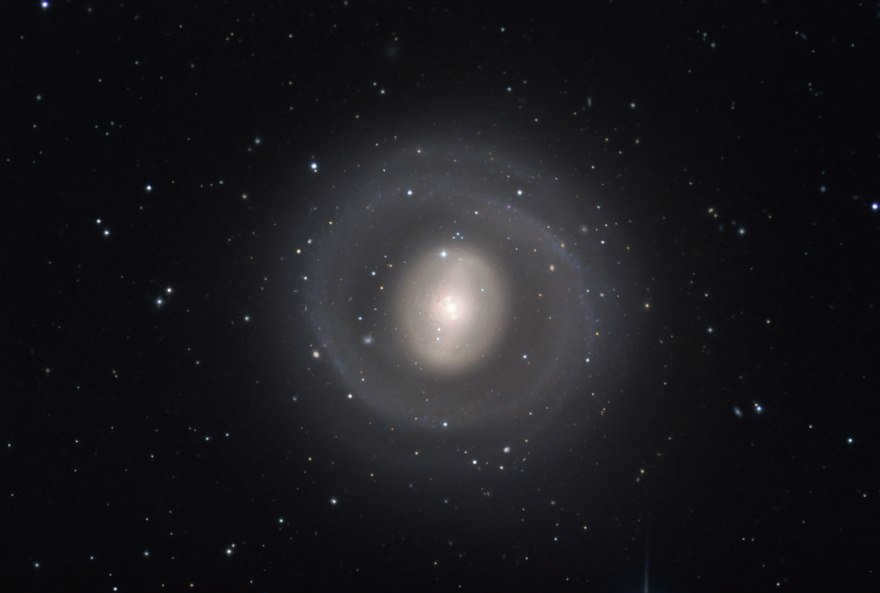
The spiral galaxy NGC 1187 has been observed in a nearly face-on orientation. With a visual magnitude of 11.4, it is located approximately 60 million light years away. This galaxy was first discovered by William Herschel in 1784. Over the past few decades, NGC 1187 has experienced two supernova explosions, SN 1982R in October 1982 and SN 2007Y in 2007.

If you want to explore the Eridanus constellation in the southern hemisphere in greater depth, you can take advantage of our collection of high-quality images, as well as access 3D models and an online telescope. For a more hands-on experience, a star map is available to assist you in your independent search.

This person doubles “m” to “mm” and “l” to “ll” (in the original “w” and “v” respectively). This person does not put ‘g’ in ‘-ing’ endings, for example, ‘somethin’. Punctuation and capitalization are not present. This person addresses trolls by shortened names (Feferi = fef, Kanaya = can, Vriska = vris). This person often uses “a” instead of “an” or “of” and “an” instead of “and”.
Eridanus Ampora, also known in Trollian as Caligulov Aquarium is one of the trolls. His zodiac sign is Aquarius (♒), and his wavy horns probably represent the symbol of Aquarius.
The origin of his name is derived from the river Eridanus, which, according to Greek mythology, was poured on Earth by Aquarius. Additionally, his name is also associated with the amphora, a Greek vessel commonly depicted in Aquarius imagery. Interestingly, when his name is read in reverse, it spells out “Nadire,” which translates to “the lowest place; the place of greatest misfortune and despair.” It is worth noting that this may simply be a coincidence.
“Eridanus” could also be derived from the star “Eridanus” or the constellation “Eridanus”, or even from the super void located in the constellation Eridanus, which is a region in the sky where the temperature is close to absolute zero. Interestingly, the Spanish translation of “amparo” is “defense,” although Eridanus is involved in the opposite line of work. If we shorten his name to its initial and final syllables, it bears some resemblance to Harry Potter (Eri’ ‘Pora’), although this may just be a mere coincidence. Presumably, his nickname in Trollian is a tribute to Troll Caligula.
Eridanus named his character in Flarp after his ancestor, the Orphan Dualskar. Dualscar was Vriska’s ancestor’s kismesis and the previous owner of Ahab’s Crossing.
- 1 Biography
- 1.1 Hivebent.
- 1.2 After Hivebent
- 1.4 Other versions
- 3.1 FEPHERI
- 3.2 VRISKA
- 3.3 SOLLUX
- 3.4 NEPETA
- 3.5 ROSE
- 3.6 CANAIA
- 3.7 CARKAT
Biography [ ]
Hivebent [ ]
Eridanus is a dweller of the sea, with one of the most noble bloodlines. His unique quirk (repeating the v and w) is a nod to the Aquarius symbol, as both of these letters resemble waves.

Eridanus has a very unique and flamboyant sense of fashion for a troll. He adorns himself with a multitude of rings and sports an extravagant cloak with a high collar, paired with a long scarf. Unlike other trolls, Eridanus stands out with a purple strand in his hair, adding a touch of color to his otherwise dark locks. His curved horns resemble the symbol of Aquarius, further accentuating his individuality.
It’s difficult to categorize Eridanus’ style, as it combines elements of a supervillain, with his collar and array of jewelry, and a hipster, with his choice of pants, boots, glasses, and unique hairstyle. The cape and scarf, along with the lightning bolt design on his zodiac symbol, horns, and colored hair strand, are a nod to the Harry Potter series, which Eridanus is particularly fond of, showing his fascination with wizards and wands.
Eridanus possesses the Cross of Ahab, a weapon he discovered aboard the haunted ship alongside Vriska’s Fluorite Octet. Our first encounter with Eridanus occurs as he employs this weapon to vanquish a flying whale destined to become sustenance for Lusus Feferi.
Teresi reveals that Eridanus was involved in a “conspiracy” privy to knowledge of Sburb, yet Eridanus carefully concealed his awareness of the subject. As a prominent and influential member of the Sea Aristocracy, Eridanus sought to acquire one of Vriska’s doomsday devices, presumably with the intent to eradicate all terrestrial inhabitants. The biological disparities between aquatic and land-dwelling trolls remain unclear, but both Eridanus and Feferi possess unique fin-like protrusions on the sides of their heads, setting them apart from other player trolls.
The hive of Eridanus is the remains of an ancient vessel, firmly attached to the dark boulders of a petite island. This provides evidence that Eridanus is capable of effortlessly breathing atmospheric oxygen, notwithstanding his facial projections that bear a resemblance to either gills or fins. In truth, Eridanus primarily occupies himself in the terrestrial realm, albeit he asserts that this choice is solely to efficiently eradicate inhabitants of the land.

Eridanus, along with Feferi, was the final troll to be introduced to us. During Hivebent, he has made fewer appearances compared to other trolls and currently has the least number of episodes featuring him. When he was first introduced, his planet had not been shown to us, and his mythological role was also unknown. The only other troll who shared this exception was Gamzee.
Following the events of Hivebent [ ]

Concealing himself in the laboratory alongside the rest of the trolls, he comes to the conclusion that all hope is lost and informs Sollux and Feferi about his intentions to form an alliance with Jack Noir. Feferi declines Eridanus’ proposition to accompany him, and Sollux opts to thwart his plans by challenging him to another duel. However, Sollux’s eye beams are nowhere near as proficient as Eridanus’ scientific wand, and he is incapacitated. In response, when Feferi launches an attack on Eridan, he fatally ends her life.

Kanaya witnesses the gruesome murder and decides to arm herself while Eridanus keeps his wand prepared. When Kanaya hesitates due to the nearby matisphere, Eridanus promptly eradicates it (and along with it, any hope of rebirth for the troll race, fully embracing his mythological role). Afterwards, he swiftly eliminates Kanaya as she launches an attack against him. Eridanus exits the room through the shifter, leaving Karkat in disbelief as he witnesses the carnage and vows to seek revenge. However, defying death, Kanaya takes matters into her own hands. Upon encountering Eridanus alongside Gamzee and Vriska during their decisive 3x battle, she swiftly incapacitates the latter two, “exposes” Eridanus’ wand, retrieves her chainsaw, and brutally cleaves him in half.
Erisolspright [ ]
The remains of Eridanus were conserved by Gamzee, who subsequently used them to bring about the creation of Erisolspright, who would serve as Jake English’s counterpart in the game.
Different Iterations [ ]

Due to the existence of multiple doomed timelines in the troll session, Eridanus has numerous alternate versions. However, only one of them has been shown so far. This particular alternate Eridanus achieved godhood before his death and was observed in a dream bubble alongside the alternate Feferi.
In Miniboiu, many other alternate Eridans can be found wearing various costumes. Additionally, there was also a presence of a specific “March Eridan”.
Personality Traits

Eridanus has a deep fascination with tales of historical figures, warlords, and conquerors. The dramatic flair in his actions and his inflated sense of self-worth can be attributed to his intense passion for extraordinary stories of fame and victory. Consequently, many perceive him as arrogant. Kanaya characterizes him as the most domineering among trolls, to the extent that even Vriska has blocked him on Trollian. Despite being aware of the nonexistence of magic, he still harbors a fondness for it, as well as wizards. This could possibly explain why he bears a slight resemblance to Harry Potter.
Kanaya claims that Eridanus has a peculiar accent, but the exact type is unknown. However, Andrew Hussey revealed that Eridanus pronounces “vv” (double v’s) as “w”. This aligns with the Latin pronunciation, where “v” is pronounced as “w”. It is reminiscent of the way English sounds in Finnish, which adds another element of humor. Additionally, Eridanus tends to use profanity frequently, although not to the extent of Gamzee, which is unexpected for someone in his aristocratic role.
Despite Eridanus passionately despising Earthlings and expressing his disdain in a dramatic manner, once he becomes involved in the game, he can’t help but become engrossed in it. Every interaction within the game becomes an opportunity for him to showcase even more theatrics. When Gamzee informs him of Sollux’s death, Eridanus experiences guilt and confesses that he behaved in a completely disrespectful manner.

Despite his claims to the contrary, he has a deep admiration for magic, to the point where he constantly bothers Rose with requests to reveal its secrets. Eventually, he manages to convince Kanaya to create a wand for him and teach him the ways of “white magic”. However, things take a dark turn when he uses his newfound power to kill both Kanaya and Feferi. Unfortunately, this act did not bring him any satisfaction or prolong his own life, as Kanaya was resurrected as the Rainbow Drinker.
“Imagine a resentful boy, consumed by nihilism, who is taken under the wing of terrifying angels. From them, he learns how to extinguish hope with their radiant light.” – D o k Scratch
Relationship [ ]
Connection [ ]
Bond [ ]
Association [ ]
Link [ ]

FEPHERI [ ]
Eridanus has developed strong feelings for Feferi, but he failed to express them properly (as he hinted during his conversation with Kanaya, and which Feferi later confirmed), resulting in a myrral relationship instead of the deeper red relationship he desired. They remained myrals for a significant amount of time. However, when Feferi enters the Medium, she decides to end her moirail relationship with Eridanus. This deeply upsets him, and despite his attempts to pursue a matesprite relationship with her, she rejects his advances. Following this rejection, Eridanus becomes consumed by jealousy and eventually lashes out at Sollux (who may have been a potential matesprite for Feferi).

Eridanus and Vriska had a turbulent romantic relationship, similar to a kismesis, but it ended abruptly just before the events of Hivebent. In an attempt to reconcile, Eridanus asks Kanaya to act as an auspaitis, but she declines his offer. Many years later, after both Eridanus and Vriska have passed away, Vriska casually mentions Eridanus and implies that she wouldn’t mind his presence on their pirate ship within the dream bubble.
SOLLUX [ ]
Eridanus clearly has a strong disliking for Sollux, especially after discovering that Feferi has a fondness for him. Consumed by jealousy, Eridanus goes to great lengths to hinder Sollux. Eridanus even goes as far as trying to establish a kismesis relationship with Sollux by proposing that Teresi become their auspaitis, but both Teresi and Sollux decline this proposition. Later on, Eridanus manipulates Feferi into becoming the auspaitis between him and Sollux, hoping to alter the dynamic between Sollux and Feferi and break their matesprites relationship. However, this plan also fails. Despite Sollux being the more skilled player at the time, Eridanus manages to defeat him in two duels.
NEPETA [ ]
Despite Eridanus’ assistance in helping her enter the Medium and saving her, Nepeta showed no interest in visiting his planet. Her heart was completely captivated by Karkat, and she didn’t seem to have much sympathy for “Mr. Ampurra” and even felt cautious around him.
ROSE [ ]
Despite attempting to persuade Rose that magic is a mere illusion, he presents her with the proposition of becoming his collaborator, asserting that they share a mutual disdain for one another. In response, she demolishes his computer, potentially failing to eradicate his affections. Subsequently, in a discussion with Vriska, he divulges his deep-seated emotions towards Rose, yet she merely mocks him.
Ampora maintains an unusual bond with Kanaya, in which he acknowledges her talent as a peacemaker, going as far as declaring that he will spare her and all the land dwellers from his murderous plans. Although harboring sinister intentions, he displays a touch of petulance and relies on the assistance of Kanaya and Feferi to navigate through life. Nevertheless, he eventually ends up killing both of them.
KARKAT [ ].
Similar to many other trolls, Eridanus often turns to Karkat for advice on romantic matters. Even before they began playing Sgrub, Eridanus and Karkat always enjoyed gossiping with each other. After Eridanus broke up with Feferi, he sought out Karkat’s advice, attempting to contact him through Gamzee and memo. However, Karkat was too preoccupied to respond at the time due to Sollux’s death. The comic implies that there were multiple conversations between Karkat and Eridanus before the deaths of Feferi and Kanaya, during which Karkat offered advice that Eridanus chose to ignore. Eridanus feels more comfortable opening up to Karkat compared to his relationship with Feferi when they were moirelles, prompting Karkat to make an effort to be less petulant with Eridanus. Even before playing Sgrub, they were already close friends, as Karkat always seemed to treat Eridanus better than most. There was even some flirting between Eridanus and the future (and possibly past) Karkat, but the latter had already witnessed future Eridanus taking the lives of Feferi and Kanaya and had no interest in pursuing a relationship for obvious reasons.

Eridanus’s Lusus is a massive seahorse, potentially referred to as the Sky Horse. Connected to it is a saddle on which Eridanus mounts for combat. He traverses atop his lusus during the pursuit of other lusus while tending to Feferi’s colossal lusus, presumably due to his responsibilities towards her. It is noteworthy that his lusus is the sole one observed donning a semblance of attire, specifically a saddle.
Interesting Facts about Eridanus
- Eridanus is often associated with the number 311, similar to how Gamzee is associated with the number 420. Here are some intriguing examples that demonstrate this connection:
- Both Eridanus and Karkat have been known to respond to TWARAZ messages, and interestingly enough, they often include the same set of numbers: 3:11 hours in the first correspondence and 311 hours in the second.
- It’s worth noting that updates posted on March 11 (3/11) somehow relate to Eridanus. In the first update, which was posted in 2011, D o k Skretch mentions Eridanus as a “a vengeful young man on the road to nihilism.” In the second update (which appears in the second interlude of Act 6), we see Eridanus from the alternate timeline standing next to Feferi, who is attempting to cure the Free Traveler.
- If Andrew’s formspring is accurate, 311 can be interpreted as an emoticon. Because 11 represents Aquarius in the zodiac and can be written as XI, the result is 3XI, which resembles a DEAD face. However, another perspective suggests that it portrays a disgruntled face.
- Alternatively, it can be seen as three times eleven, specifically 11.11.11, a significant date for the B2 session. Although this is likely just a coincidence.
- Eridanus probably didn’t know that “Prince” translates to “Destroyer” and continued to view himself as someone of noble lineage, believing he had authority in matters related to hope. He also wasn’t cautioned against killing the inhabitants of his land by an angel (despite their aggression only starting after Eridanus began destroying them).
Eridanus, a large elongated constellation, is situated in the southern hemisphere of the sky. It holds the 6th position in terms of size among all constellations, covering an area of 1138 square degrees. According to the celestial map, it shares borders with several other constellations, including Hare, Whale, Orion, Furnace, Chisel, Taurus, Toucan, Phoenix, Bowl, and Southern Hydra.
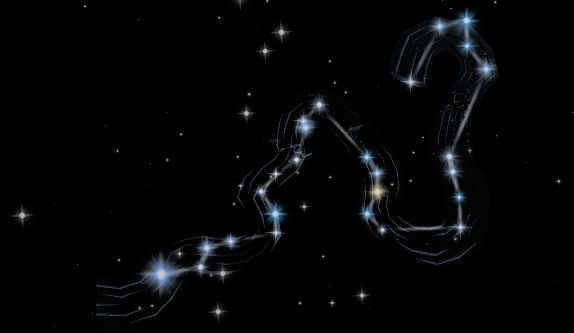
The origin of the Eridanus constellation
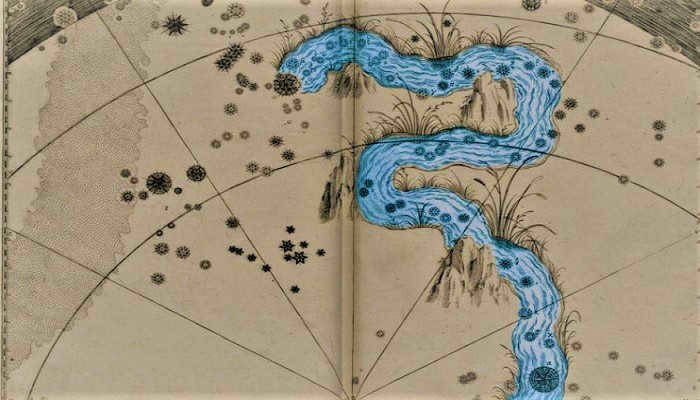
The constellation Eridanus is composed of stars.
There are approximately 190 stars that can be seen with the naked eye. Let’s explore the main stars in this area.
First up is the brightest star, Alpha-Ahernar. It belongs to the main sequence and has an apparent magnitude of 0.445. Interestingly, it is one of the top ten brightest stars in the entire sky, ranking 6th. It is eight times more massive than the Sun and has a shape resembling a flattened spheroid. Additionally, this star has a remarkably high rotational speed, which likely resulted in the formation of a gas disk around it.
The next brightest star is often Beta of the constellation Cursus. It is a blue giant with an apparent magnitude of 2.796. It also has a high rotational velocity and has been observed to have a visual companion.
Theta is a double star known as Akamar, consisting of two stars in the spectral classes A4 and A1. Its average brightness is 3.2.
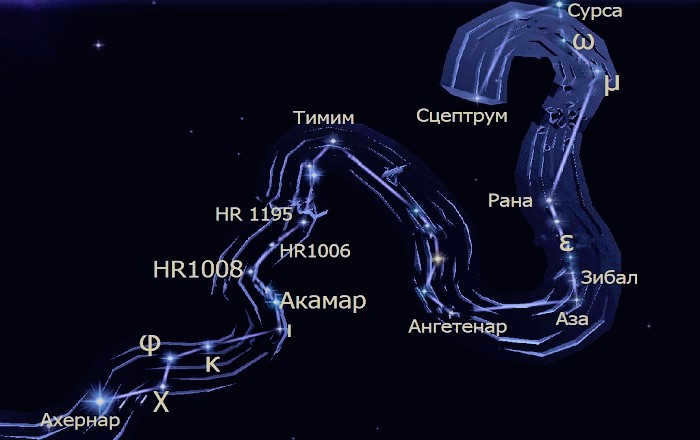
What are the hidden objects within the constellation Eridanus
There are actually numerous fascinating astronomical objects located in this region.
One notable example is the nebula known as The Witch’s Head. Despite being a faint reflecting nebula, it is highly regarded among astronomers. It is believed to have originated from a supernova explosion and is illuminated by the brightest star in the world, Rigel, from the constellation Orion.
An illustration of the constellation’s diversity is the Eridanus group, often referred to as the Eridanus Cloud. In reality, it is a collection of 200 galaxies where the spiral type of systems predominates.
Additionally, the area also contains several spiral galaxies, including NGC 1187, NGC 1232, NGC 1234, NGC 1300, NGC 1309, and NGC 1332.
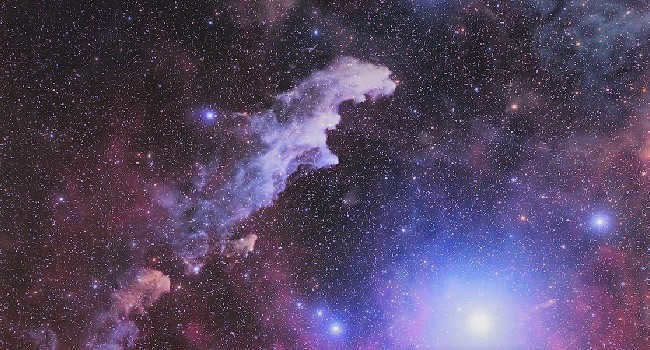
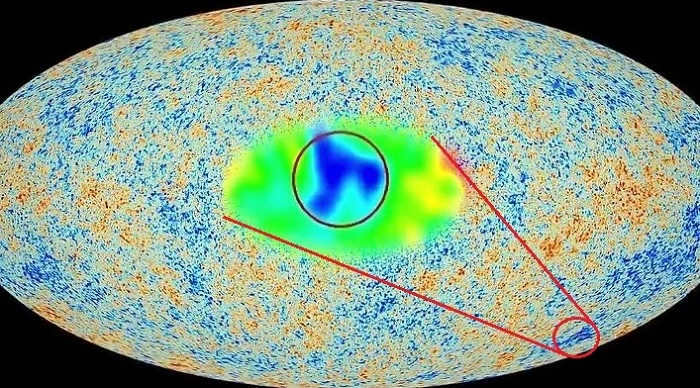
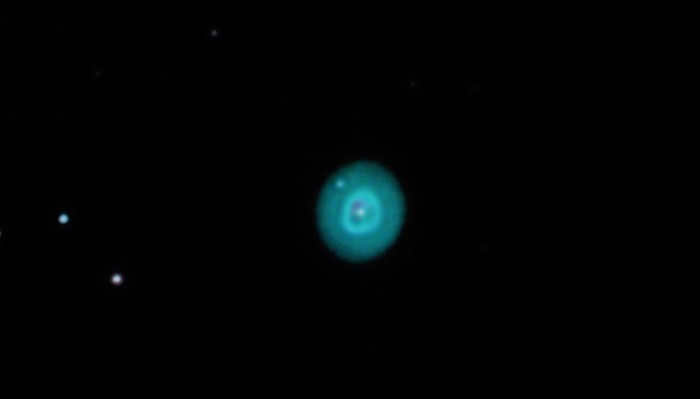
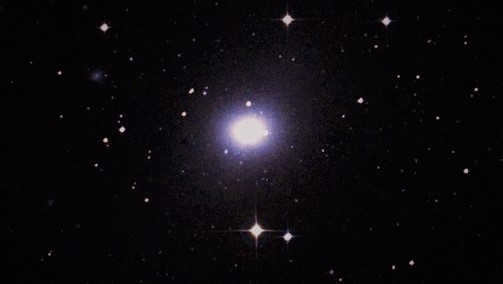
Observation
It has been discovered that the visibility of the constellation Eridanus lies within latitudes ranging from +32 to -90. Moreover, the further south you travel, the more prominent the constellation becomes. The optimal time for observing Eridanus is in November. While the region is partially visible from Russia, it is not fully observable.

Eridanus is a vast constellation that stretches across the southern hemisphere of the celestial sky. It is the sixth largest constellation, covering an impressive 1138 square degrees. On the celestial map, Eridanus shares its borders with several other constellations, including Hare, Whale, Orion, Furnace, Chisel, Taurus, Taurus, Toucan, Phoenix, Bowl, and Southern Hydra.

The Origins of the Eridanus Constellation
This particular region of the celestial sphere has been recognized since ancient times, with its first documentation coming from Greek astronomers.
Because of its elongated form and impressive magnitude, the constellation has often been likened to a flowing river. This is likely the reason behind its name, as Eridanus is a water feature, specifically a river, mentioned in ancient Greek mythology.
Furthermore, there exists a tale surrounding the offspring of the deity Helios, the Sun god. This individual, known as Phaeton, was said to have taken control of the celestial chariot. However, there are two differing accounts as to why Eridanus was immortalized. The initial version suggests that Zeus, in a fit of rage, cast Phaeton into the river. Alternatively, it is proposed that the constellation mirrors the trajectory of Phaeton’s chariot.

Stars that make up the constellation Eridanus.
There are approximately 190 celestial objects that can be seen with the naked eye. Let’s examine the primary stellar components within this region.
First and foremost, we have the brightest star, known as Alf.а – Ahernar. This star belongs to the main sequence and has an apparent magnitude of 0.445. Interestingly, it is among the top ten brightest stars in the entire sky, ranking 6th. It has a mass eight times greater than that of the Sun and has a shape reminiscent of a flattened spheroid. Additionally, it exhibits an incredibly fast rotational speed, which may have contributed to the formation of a gas disk around it.
Following suit in terms of brightness is Beta of the constellation, also referred to as Cursus. This blue giant has an apparent magnitude of 2.796 and, much like the previous star, boasts a high rotational velocity. It has even been discovered to have a visual companion.
Theta is a binary star system known as Akamar, which is made up of two luminous stars classified as A4 and A1 in terms of spectral class. The average brightness of this system is 3.2.

Delta.also known as Ranais a subgiant with a magnitude of 3.54.
Epsilon of the area (Sadira) is a main-sequence star with a brightness of 3.736. Interestingly, this celestial body is the ninth nearest to the Sun. According to astronomers, it can be observed in the sky without the aid of a telescope. Additionally, it has a planet in its orbit.
Omicron 1 – a giant star that appears yellow and white. Meanwhile, Omicron 2 is a star known as Cade.. It is actually a triple system consisting of three dwarf stars.
Hee is a subgiant with a yellow color.
It is a subgiant with a yellow color. and 53 Eridana are giants that have an orange color.
At last, Gamma (Zaurak), Mu, Tau-1, Tau-4, Tau-5, Tau-8, Tau-9, and Zeta Eridanus exhibit a binary nature.
It is evident that the Eridanus constellation harbors numerous distinct stellar constituents. Without a doubt, collectively they create a remarkable assemblage.
What lies hidden in the constellation Eridanus
There are actually a number of fascinating celestial objects located in this region.
One such object is the nebula known as The Witch’s Head. Despite being a dim reflecting nebula, it holds great appeal for astronomers. It is thought to have formed following a supernova explosion and is illuminated by the brightest star in the world, Rigel, found in the constellation of Orion.
The Eridanus group exemplifies the diversity within the constellation. It is often referred to as the Eridanus cloud. In reality, it is a collection of 200 galaxies, with the spiral type of systems prevailing.

Notably, the brilliant elliptical galaxy NGC 1395. Additionally, the constellation includes dwarf representatives: NGC 1531 and NGC 1427A. Moreover, a ring system has been discovered, NGC 1291, which boasts a unique arrangement with an outer ring and an inner bar.
Despite the abundance of gravitationally bound systems, there are other celestial objects worth mentioning. One such object is A relict cold spot. This cold super void in Eridanus is the largest of all known cold spots in space. It was detected through microwave observations of the cosmos.
Currently, modern astronomy struggles to explain the origin of cold spots in the Universe. However, their existence cannot be denied, and they rightfully hold their place in the cosmic landscape.
To add the finishing touch, there is a planetary nebula, NGC 1535, situated within the constellation Eridanus. This celestial object is frequently likened to the Eskimo Nebula, which is located in the Gemini constellation.






